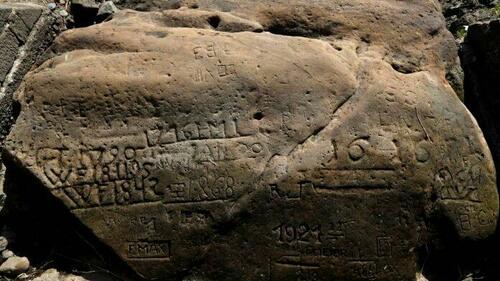Hitler’s Scuttled Black Sea Fleet, Centuries-Old ‘Hunger Stones’ Emerge From Dry Riverbeds In Drought-Stricken Europe
Extreme droughts across Europe are revealing thousands of years of lost history.
In some regions, centuries-old warning messages etched into boulders have been exposed. As StrangeSounds.org reports, these rocks – known as “Hungersteine” or “Hunger Stones”
One stone, embedded in the Elbe River, which runs from the mountains of Czechia through Germany to the North Sea, dates back to a drought in 1616, is once again visible in the dry riverbed.
The warning reads, “Wenn du mich seehst, dann weine” – “If you see me, weep.”
“Hunger stones” like this one were used as “hydrological landmarks” across central Europe, NPR reported when the stones last surfaced during a 2018 drought.
These stones are “chiselled with the years of hardship and the initials of authors lost to history,” a team of Czech researchers wrote in a 2013 study.
“The basic inscriptions warn of the consequences of drought. It expressed that drought had brought a bad harvest, lack of food, high prices and hunger for poor people.”
Europe’s current drought is certainly historic. As StrangeSounds.org goes on to note, the XIV century Mesta Bridge in Villarta de los Montes (Extremadura, Spain), a nice example of Mudéjar-Gothic civil engineering. Since 1956 it’s been covered by the waters of the Cijara Reservoir, but the drought has brought it back to light.
This medieval bridge was flooded in the fifties to create the Cijara reservoir in central Spain. Now it’s exposed again as a drought parches Spain’s arid regions https://t.co/S3zsZwOqve pic.twitter.com/BwybpYwHUr
— Reuters (@Reuters) August 11, 2022
The remains of the Aquis Querquennis Roman castrum in Galicia, which is normally covered by the waters of the Lima River and the Concha reservoir. It dates back to the III century and was on the Via Nova.
A view of the Roman camp Aquis Querquennis, located on the banks of the Limia River in Galicia, Spain. The camp is usually under water but can now be seen because of the low water levels. pic.twitter.com/LDP0X1sc9g
— BBC Weather (@bbcweather) August 10, 2022
As Italy faces “the most serious water crisis in the last 70 years,” a 450lb , World War II-era bomb was exposed in the dried up Po River bed…
The water level in Italy’s drought-stricken Po River is so low that even a WWII-era bomb reemerged.
It was no easy task to remove the 450-kilogram bomb. pic.twitter.com/xdEYKaIfoi
— DW News (@dwnews) August 12, 2022
In Spain, the Valdecanas reservoir has dried up and revealed a prehistoric stone circle dubbed the “Spanish Stonehenge,” officially known as the Dolmen of Guadalperal, which has been covered by water since 1963…
Finally, and perhaps most dramatically, a Nazi fleet of 20 World War German warships re-surfaced as the water level in the River Danube in Serbia plunged to extreme lows…
Hitler’s Black Sea fleet was scuttled in 1944 as the German army retreated from Soviet forces, Reuters report.
According to The Washington Post, many more ships are thought to be buried under the river’s sandbanks.
Tyler Durden
Sun, 08/21/2022 – 07:35

